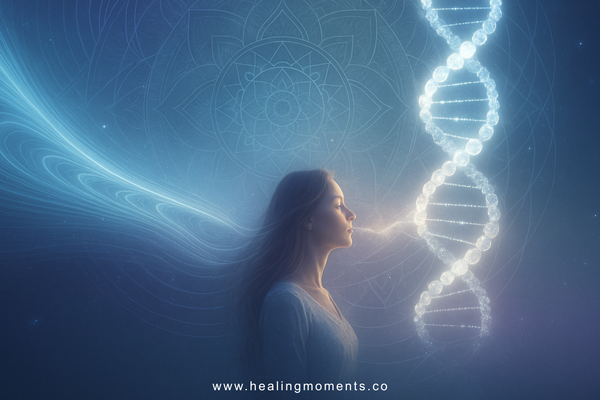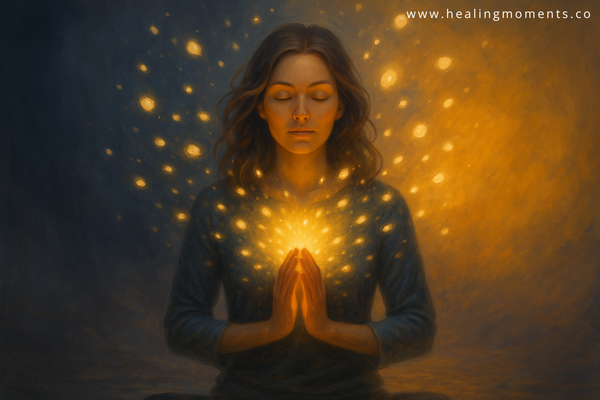The 7 Chakras: A Complete Guide to Understanding and Balancing Your Energy Centers
Share
Introduction: The Ancient Wisdom of Chakras
Have you ever felt that something was “off” in your body or mind, but couldn’t quite put your finger on it? The ancient system of chakras might offer insights that modern medicine sometimes overlooks. The chakras energy centers are the body’s main power sources that influence our physical, emotional, and spiritual wellbeing. These spinning wheels of energy have been recognized for thousands of years in Eastern traditions, particularly in Hindu and Buddhist practices.
Today, even as we embrace modern science and medicine, many people are rediscovering these ancient energy concepts to support their emotional and physical wellness. This complete guide to chakras will help you understand how each energy center affects your wellbeing, whether you’re a curious beginner or looking to deepen your existing practice.
What Are Chakras? Understanding Energy Centers
The word “chakra” comes from Sanskrit, meaning “wheel” or “disk.” Chakras energy centers can be thought of as invisible spinning wheels of energy located throughout your body. These energy centers don’t show up on medical scans, but their effects can be felt in your physical body, emotions, and mental state.
Think of chakras as power stations that distribute energy throughout your system. When these stations function well, energy flows freely, and you experience health and vitality. When they’re blocked or imbalanced, you might experience physical symptoms or emotional challenges.
Ancient traditions view chakras energy centers as the connection points between physical and spiritual aspects of our being. While there are actually many minor chakras throughout the body, most traditions focus on the seven major chakras that run along the spine from its base to the crown of the head.
The 7 Chakras Overview
Learning about chakras and their effects can transform how you approach your physical and emotional health. When you understand which chakra governs certain aspects of your life, you gain valuable insights into addressing imbalances before they manifest as more serious problems.
Now, let’s explore each chakra in detail, starting from the foundation and working our way up.
The Root Chakra: Foundation of Your Energy System

Location: Base of spine (tailbone area)
Color: Red
Element: Earth
A balanced root chakra muladhara helps you feel secure, stable, and connected to your physical body. This first energy center is all about your basic needs and sense of safety in the world. It’s named Muladhara in Sanskrit, which means “foundation” or “root support.”
The root chakra governs your:
- Sense of safety and security
- Basic survival needs (food, shelter, etc.)
- Connection to your physical body
- Stability and groundedness
- Family bonds and tribal connections
When your root chakra is balanced, you feel:
- Secure and safe in the world
- Confident about meeting your basic needs
- Physically healthy and energetic
- Connected to your body
- Grounded and stable
Signs of Root Chakra Imbalance
When this energy center is blocked or imbalanced, you might experience:
Physical symptoms:
- Lower back pain
- Sciatica
- Constipation
- Weight issues
- Immune system problems
Emotional symptoms:
- Anxiety about basic survival
- Financial insecurity fears
- Feeling ungrounded or “spacey”
- Trust issues
- Excessive fear or worry
Simple Root Chakra Balancing Practices
To strengthen and balance your root chakra:
- Walk barefoot on natural ground (grass, sand, dirt)
- Eat root vegetables like carrots, potatoes, and beets
- Wear red clothing or accessories
- Practice grounding yoga poses like Mountain Pose or Child’s Pose
- Use affirmations like “I am safe” or “I am secure and grounded”
The Sacral Chakra: Unlocking Your Creative Energy

Location: Lower abdomen (about 2 inches below navel)
Color: Orange
Element: Water
The sacral chakra governs creativity, pleasure, and emotional balance in our lives. Called Svadhishthana in Sanskrit (meaning “one’s own place”), this energy center is connected to how you experience pleasure, passion, and the sweetness of life.
This chakra influences:
- Creativity and artistic expression
- Sexuality and sensuality
- Emotional fluidity
- Pleasure and joy
- Reproductive health
When your sacral chakra is balanced, you:
- Feel comfortable with your sexuality
- Express creativity freely
- Experience healthy relationships
- Process emotions with ease
- Find joy in life’s pleasures
Signs of Sacral Chakra Imbalance
An imbalanced sacral chakra might manifest as:
Physical symptoms:
- Reproductive issues
- Urinary problems
- Lower back pain
- Hip tightness
- Low libido or sexual dysfunction
Emotional symptoms:
- Emotional numbness or oversensitivity
- Creative blocks
- Fear of pleasure
- Dependency in relationships
- Difficulty setting boundaries
Simple Sacral Chakra Balancing Practices
To nurture your sacral chakra:
- Take a warm bath with orange essential oils
- Dance freely to music you love
- Create art without judgment
- Eat orange foods like mangoes, oranges, and carrots
- Practice hip-opening yoga poses like Butterfly or Goddess Pose
The Solar Plexus Chakra: Your Center of Personal Power

Location: Upper abdomen (stomach area)
Color: Yellow
Element: Fire
When your solar plexus chakra is balanced, you feel confident and empowered in your decisions. Known as Manipura in Sanskrit (meaning “city of jewels”), this energy center governs your personal power, self-confidence, and metabolism.
The solar plexus chakra influences:
- Self-esteem and confidence
- Personal power and autonomy
- Willpower and determination
- Metabolism and digestion
- Mental clarity and intellect
When this chakra is balanced, you:
- Trust your instincts
- Feel confident in your abilities
- Make decisions easily
- Set and maintain healthy boundaries
- Feel energetic and motivated
Signs of Solar Plexus Chakra Imbalance
An imbalanced solar plexus might show up as:
Physical symptoms:
- Digestive issues (acid reflux, ulcers, etc.)
- Stomach pain or butterflies
- Eating disorders
- Chronic fatigue
- Liver or gallbladder problems
Emotional symptoms:
- Low self-esteem
- Need to control others
- Difficulty making decisions
- Anger management issues
- Perfectionism or harsh self-criticism
Simple Solar Plexus Chakra Balancing Practices
To strengthen your solar plexus:
- Practice core-strengthening exercises
- Spend time in sunlight
- Eat yellow foods like bananas, corn, and pineapple
- Use affirmations like “I am confident” or “I trust my decisions”
- Try yoga poses like Boat Pose or Warrior III
The Heart Chakra: Connecting to Love and Compassion

Location: Center of chest (heart area)
Color: Green
Element: Air
The heart chakra serves as the bridge between the lower and upper energy centers. Called Anahata in Sanskrit (meaning “unhurt” or “unstruck”), this chakra is the center of love, compassion, and connection.
This energy center governs:
- Love (both giving and receiving)
- Compassion and empathy
- Forgiveness and acceptance
- Harmony and peace
- Connection to others
When your heart chakra is balanced, you:
- Give and receive love freely
- Maintain healthy relationships
- Practice compassion toward yourself and others
- Feel connected to the people around you
- Experience inner peace
Signs of Heart Chakra Imbalance
An imbalanced heart chakra might manifest as:
Physical symptoms:
- Heart problems
- Lung issues or asthma
- Upper back and shoulder tension
- Immune system problems
- Breast issues
Emotional symptoms:
- Fear of intimacy
- Holding grudges
- Excessive jealousy
- Codependency or isolation
- Difficulty forgiving yourself or others
Simple Heart Chakra Balancing Practices
To open and balance your heart chakra:
- Practice loving-kindness meditation
- Spend time in nature
- Wear or surround yourself with green
- Practice chest-opening yoga poses like Cobra or Camel
- Keep a gratitude journal
The Throat Chakra: Expressing Your Authentic Voice

Location: Throat region
Color: Blue
Element: Ether/Space
An open throat chakra allows you to communicate your truth with clarity and confidence. Known as Vishuddha in Sanskrit (meaning “especially pure”), this energy center governs communication, self-expression, and the ability to speak your truth.
The throat chakra influences:
- Communication and self-expression
- Speaking your truth
- Listening skills
- Creative expression through voice
- Living authentically
When this chakra is balanced, you:
- Communicate clearly and effectively
- Express your needs and desires
- Listen attentively to others
- Speak your truth with confidence
- Live in alignment with your values
Signs of Throat Chakra Imbalance
An imbalanced throat chakra might show up as:
Physical symptoms:
- Sore throats and throat infections
- Thyroid issues
- Dental problems
- Neck and shoulder tension
- Voice problems
Emotional symptoms:
- Difficulty expressing yourself
- Fear of speaking up
- Talking too much or too little
- Lying or being unable to keep secrets
- Not listening to others
Simple Throat Chakra Balancing Practices
To nurture your throat chakra:
- Sing or hum (even in the shower!)
- Practice neck stretches
- Drink herbal teas with honey
- Write in a journal to clarify your thoughts
- Try yoga poses like Shoulder Stand or Fish Pose
The Third Eye Chakra: Developing Your Intuition

Location: Between the eyebrows
Color: Indigo
Element: Light
Developing your third eye chakra can enhance intuition and inner wisdom. Called Ajna in Sanskrit (meaning “command” or “perceiving”), this energy center governs intuition, imagination, and perception.
The third eye chakra influences:
- Intuition and insight
- Imagination and visualization
- Perception beyond the physical
- Wisdom and discernment
- Memory and concentration
When this chakra is balanced, you:
- Trust your intuition
- See the bigger picture
- Think clearly and concentrate easily
- Have vivid dreams and imagination
- Access inner wisdom
Signs of Third Eye Chakra Imbalance
An imbalanced third eye might manifest as:
Physical symptoms:
- Headaches and migraines
- Vision problems
- Sinus issues
- Neurological problems
- Sleep disorders
Emotional symptoms:
- Difficulty trusting intuition
- Overthinking and anxiety
- Confusion about life direction
- Difficulty concentrating
- Feeling spiritually disconnected
Simple Third Eye Chakra Balancing Practices
To open and balance your third eye:
- Practice meditation focusing on the third eye area
- Reduce screen time, especially before bed
- Use essential oils like lavender or frankincense
- Try yoga poses like Child’s Pose with forehead touching the ground
- Keep an intuition journal to track insights
The Crown Chakra: Connecting to Higher Consciousness

Location: Top of the head
Color: Violet or White
Element: Thought/Consciousness
The crown chakra connects you to universal consciousness and spiritual understanding. Known as Sahasrara in Sanskrit (meaning “thousand-petaled”), this energy center is about spiritual connection, higher consciousness, and your sense of purpose.
This chakra governs:
- Spiritual connection
- Higher consciousness
- Universal wisdom
- Life purpose and meaning
- Connection to something greater than yourself
When your crown chakra is balanced, you:
- Feel a sense of purpose
- Experience moments of bliss or transcendence
- Trust in the flow of life
- Feel connected to all living things
- Experience inner peace
Signs of Crown Chakra Imbalance
An imbalanced crown chakra might show up as:
Physical symptoms:
- Headaches
- Sensitivity to light and sound
- Neurological disorders
- Chronic fatigue
- Skin issues on the scalp
Emotional symptoms:
- Feeling disconnected from life
- Excessive materialism
- Rigid thinking
- Spiritual addiction or bypassing
- Lack of purpose or direction
Simple Crown Chakra Balancing Practices
To nurture your crown chakra:
- Practice silent meditation
- Spend time in prayer or spiritual contemplation
- Try fasting (with medical supervision if needed)
- Use essential oils like frankincense or sandalwood
- Practice yoga poses like Headstand (with proper instruction) or Lotus Pose
How to Balance Chakras: Practical Techniques for Everyday Life
Understanding how chakras energy centers function can help you identify imbalances in your life. But knowing about chakras is just the beginning—the real benefit comes from actively working with them. Here are some practical chakra balancing techniques you can incorporate into your daily routine:
1. Chakra Meditation: Simple Practices for Each Energy Center
Chakra meditation is one of the most direct ways to influence your energy centers. Try this simple practice:
- Sit comfortably with your spine straight
- Take several deep breaths to center yourself
- Starting with the root chakra, visualize a glowing red ball of energy at the base of your spine
- As you inhale, imagine this energy growing brighter and clearer
- As you exhale, imagine any blockages dissolving
- Spend 1-2 minutes on each chakra, moving up through the body
- End with a moment of gratitude for your practice
Regular chakra meditation can help maintain alignment in your energy system.
2. Chakra Balancing Techniques: Yoga Poses for Energy Alignment
Specific yoga poses can target and balance each chakra:
- Root Chakra: Mountain Pose, Chair Pose
- Sacral Chakra: Goddess Pose, Pigeon Pose
- Solar Plexus: Boat Pose, Warrior III
- Heart Chakra: Camel Pose, Cow Face Pose
- Throat Chakra: Plow Pose, Fish Pose
- Third Eye: Child’s Pose, Eagle Pose
- Crown Chakra: Headstand (with proper instruction), Corpse Pose
Even a short 15-minute yoga practice focusing on a specific chakra can make a noticeable difference in how you feel.
3. Sound Healing for Chakras
Each chakra resonates with a specific sound or mantra:
- Root Chakra: LAM
- Sacral Chakra: VAM
- Solar Plexus: RAM
- Heart Chakra: YAM
- Throat Chakra: HAM
- Third Eye: OM
- Crown Chakra: Silence or AUM
Chanting these sounds or listening to chakra-specific music can help balance your energy centers.
4. Chakra Healing: Methods to Restore Your Energy Balance
Many practitioners use sound, crystals, and touch for effective chakra healing. Here are some popular methods:
- Crystal Healing: Place specific crystals on chakra points while lying down
- Root: Red jasper, black tourmaline
- Sacral: Carnelian, orange calcite
- Solar Plexus: Citrine, yellow calcite
- Heart: Rose quartz, green aventurine
- Throat: Blue lace agate, turquoise
- Third Eye: Amethyst, lapis lazuli
- Crown: Clear quartz, amethyst
- Color Therapy: Surround yourself with the color associated with the chakra you’re working on
- Essential Oils: Use chakra-specific oils for massage or aromatherapy
- Reiki: Energy healing that often focuses on chakra balancing
Effects of Chakra Imbalance: Signs Your Energy Centers Need Attention
The effects of chakra imbalance can manifest as physical ailments or emotional distress. Here are some common signs that your chakras might need attention:
- Persistent physical problems in areas associated with specific chakras
- Recurring emotional patterns that you can’t seem to break
- Feeling “stuck” in certain areas of your life
- Energy fluctuations — either too much (hyperactivity) or too little (lethargy)
- Intuitive hints — sometimes you just “know” something is off
By paying attention to these signs, you can address imbalances before they develop into more serious issues.
Integrating Chakra Awareness into Daily Life
Learning about chakras isn’t just for yoga teachers or energy healers—it’s practical knowledge that anyone can use to improve their wellbeing. Here are some simple ways to bring chakra awareness into your everyday life:
- Morning check-in: Take a moment each morning to scan your body and notice which chakras feel open or blocked
- Color choices: Intentionally wear colors associated with chakras you want to strengthen
- Mindful eating: Choose foods that support specific chakras when needed
- Targeted exercise: Select physical activities that engage chakras requiring attention
- Evening reflection: Before bed, notice which chakras were active or blocked during your day
Conclusion: Your Journey with Chakras
The chakra system offers a map for understanding the connection between your physical body, emotions, and spiritual wellbeing. By learning to recognize imbalances and applying simple techniques to address them, you can take an active role in your health and happiness.
Remember that working with chakras is a personal journey. What works for someone else might not work for you, and that’s perfectly fine. Trust your intuition and notice what practices make you feel more balanced and aligned.
Whether you’re dealing with physical discomfort, emotional challenges, or simply seeking greater harmony in your life, the ancient wisdom of the chakra system provides practical tools for modern living. Start with small steps, be patient with yourself, and enjoy the process of discovery.




